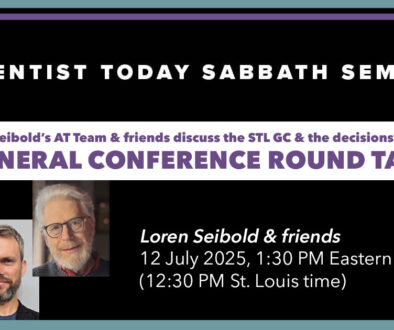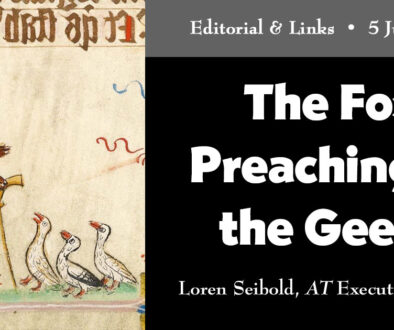Hidden Treasures in Stolen Dirt
By Debbonnaire Kovacs, June 10, 2015
On the weekend of April 23-25, 2015, Israeli archaeologist Aran Yardeni told a startling story at Walla Walla University. In 1999, he said, when he was a second year student of archaeology at Bar-Ilan University in Ramat Gan, Israel, a friend and fellow student, Zachi Dvira (whose name at the time was Zachi Zweig) happened to see large trucks full of soil coming out of one of the gates of the Temple Mount. He found this not only strange, but suspicious, and called Yardeni. Together, the two young men followed the trucks to “a local Jerusalem garbage dump.”
“At the garbage dump…it’s a long story,” Yardeni said, “but we managed to convince the authorities there to allocate the trucks on site so that we could check them, and instead of dirt, what we found there was a pile of archaeological finds.” The students found items ranging from the Second Temple period to the Early Modern period. They could not believe these ancient treasures, the first ever found from inside the Muslim-controlled Temple Mount, were being trucked out and dumped.
They put some things in plastic bags and went directly to their professor, Gabi Barkai, who was stunned at the variety and wide dating of the finds. Two weeks later, they were able to present some of their finds at a conference for Jerusalem Studies.
That’s when the dirt really began to fly.
According to a Wikipedia article about Zachi Dvira, “Just as they began collecting artifacts, they were stopped by inspectors from the Israeli Antiquities Authority. The students managed to retrieve a few artifacts from the dump and displayed them at a conference about new studies on Jerusalem. Their report was followed by a storm in the conference hall. The Antiquities Authority claimed these students are antiquities robbers, but all the archaeologists in attendance deeply supported them and protested against the archaeological destruction of the Temple Mount.”
A few days later, the two students’ homes were searched, and they were arrested on charges of antiquities robbery. The charges were dismissed, but the students filed a suit in the Supreme Court against the state of Israel, because still, the dump trucks and bulldozers were hauling away huge loads of dirt and treasure and dumping it.
In talking to the Walla Walla University group, Yardeni had difficulty expressing the depth of his feelings as he showed Palestinian television footage (released years later) of what looked like any freeway construction site, with heavy earth-moving equipment and the Martian landscape they create, in the area known as Solomon’s Stables.
“Let me just share: if I would dig that place—we’re talking about the most important site in biblical archaeology—I would be coming with my dental kit, okay? I would be brushing—we’d—it’s a very, very thorough investigation that we hold, and uh, to see this—this condition—I don’t know if you understand, but for an archaeologist, this is…uh…” Yardeni hesitated. “It’s—it’s—it’s a crime!”
He pointed out that this can never be restored. The destruction of the site is irrevocable.
It took five years of court battles, but in 2004, again quoting Wikipedia, “they obtained the license and 285 truckloads of rubble were moved to a vacant lot on the slopes of Jerusalem’s Mount Scopus, where Zweig directs a dig that sifts and examines every bucketful of dirt and rubble removed from the Temple Mount.”
Today, all that dirt is owned by the Temple Mount Sifting Project. Dvira and his team came up with something they call “wet sifting.” They soak a bit of dirt and then direct a strong stream at it, washing away actual soil and dust and leaving bits and pieces of everything from stones and pottery shards to rings, seals, roofing tiles, mosaics…in short, incalculable treasure. Although all the careful study that would normally occur while keeping all artifacts precisely where they were located, thus helping with dating and provenance, cannot occur, there is still a great deal to be learned. In ten years, the team has found tens of thousands of items, and they’ve only sifted 40% of the soil. Here are a few of the most amazing:
- A first century half shekel used as temple tax, one of only a handful known to be in existence, the only one from the actual Temple Mount, and probably minted on site. Yardeni makes the connection to Jesus and the rebuking of the money changers, though the coin itself is a little later.
- A clay seal with the only ancient Hebrew inscription ever found on the Temple Mount. This seal bears the name of the son of Immer, a family of temple officials mentioned in Jeremiah 20:1.
- Some dice of the type used by Roman soldiers, such as the ones they used at Jesus’ crucifixion.
The good news is, because the team is not working in situ, anyone can help. They have people from all over the world who come, get what Yardeni calls “a half-hour crash course in archaeology” that tells them what they’re looking for, and start wet sifting piles of dirt. When the helpers have sifted out the pieces, one of the experts looks it over before letting them throw away even what they might think are “just rocks.”
It was Dr. Carl Cosaert, professor of Biblical Studies and Chair of the Faculty at WWU, who was behind Yardeni’s visit to the university. They met by chance a few years ago when Dr. Cosaert was leading a group of students in his first tour of Israel. They were to go down into Hezekiah’s tunnel, and their guide told them he had called someone else to lead them. “It kind of surprised me that we were being sub-leased to another guide, but we were told, ‘well, he knows a lot more, you’ll like him.’”
Cosaert says Yardeni’s view of the meeting is that it was “completely a God thing.” He wasn’t scheduled to work that day, and just happened to be there when a call came in saying they needed a guide who was a knowledgeable person for a professor and some students. Yardeni was the most senior one there, so he took the call.
“His presentation was fabulous! He kept showing how, in so many ways, archaeology gives insights into the Bible. I asked if he led groups, and since then I’ve done a dozen tours in Israel and elsewhere, and Aran is the one I’ve always had when I’m in Israel. We’ve built a great relationship—he calls me his pastor, though he would not identify as either Jewish or Christian in religion, but as a seeker. He is very deeply spiritual.”
Coseart said several times that he and Yardeni are “tuned in to the same things.” When he first went to Israel, he experienced what he called “a typical tour—all the traditional church sites—it’s one church after another.” Cosaert said that wasn’t what he wanted—he wanted to experience what life was really like for people in Bible times. So, for example, his tours do stop and see the traditional Gethsemane site, but then, in the evening, the group will go a little way from the traditional site, have a little worship, and then each find their own private olive tree and pray and meditate. Or they’ll go out in the desert at night, lie on the ground and watch the stars, and talk about Abraham.
They have even rented a cross and carried it through the streets of Jerusalem.
“I want to connect with the stories in real, tangible ways. Aran gives such depths historically and archaeologically, and that allows me to focus on spiritual connections to Jesus—the two together are a real blessing.”
If you would like to go on one of the Holy Land tours led by Dr. Cosaert and Aram Yardeni, you may. They have a student tour coming up fast, but their next one for adults is a ten-day tour of the Middle East from March 16-27. Visit Dr. Cosaert’s webpage here for more information.
To hear Aran Yardeni tell his whole story, watch footage of the destruction and of the digging and sorting going on now, and see many of the best artifacts, visit this YouTube video. The first 14 minutes are an overview of Temple Mount and its history. The story of the “stolen dirt” begins at 14; you can see the astonishing list of their finds to date at 29:05, go on a virtual tour of the temple as it was in Jesus’ time at about 33, and see the famous temple half shekel at 36. The whole video is just over an hour, and while not professionally done (I had to use earphones to hear), it is worth it in my view.
For other tellings of the controversial story of the digging, here are two wiki articles:
https://en.wikipedia.org/wiki/Zachi_Dvira
https://en.wikipedia.org/wiki/Excavations_at_the_Temple_Mount



